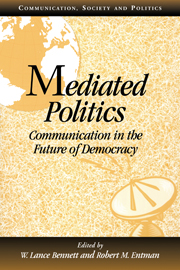Book contents
- Frontmatter
- Contents
- List of Figures
- List of Tables
- Contributors
- Preface
- Acknowledgments
- 1 Mediated Politics: An Introduction
- Part 1 Democracy and the Public Sphere
- 2 The Public Sphere and the Net: Structure, Space, and Communication
- 3 Promoting Political Engagement
- 4 The Internet and the Global Public Sphere
- Part 2 Citizens, Consumers, and Media in Transition
- Part 3 Mediated Political Information and Public Opinion
- Part 4 Mediated Campaigns
- Part 5 Citizens: Present and Future
- Index
2 - The Public Sphere and the Net: Structure, Space, and Communication
Published online by Cambridge University Press: 05 June 2012
- Frontmatter
- Contents
- List of Figures
- List of Tables
- Contributors
- Preface
- Acknowledgments
- 1 Mediated Politics: An Introduction
- Part 1 Democracy and the Public Sphere
- 2 The Public Sphere and the Net: Structure, Space, and Communication
- 3 Promoting Political Engagement
- 4 The Internet and the Global Public Sphere
- Part 2 Citizens, Consumers, and Media in Transition
- Part 3 Mediated Political Information and Public Opinion
- Part 4 Mediated Campaigns
- Part 5 Citizens: Present and Future
- Index
Summary
While the public sphere as a general notion appears in a variety of ways in the writings of many authors in the twentith century, such as Walter Lippman,Hannah Arendt, and John Dewey, most people today associate the concept with Jürgen Habermas's particular version. Written in the early 1960s, his original text was translated into English only a decade ago (Habermas 1989). Since this translation, use of the concept has grown considerably in the Anglo-American world. Over the years there have been many critical interventions around the concept (see Calhoun 1992, for the best collection), and while Habermas has not attempted a full-scale reformulation of the public sphere, it is clear that his view of the concept is evolving as his work in other areas develops (Habermas 1996). While I cannot here trace all the contributions and debates around the public sphere (I probe the concept more extensively in Dahlgren 1995), my aim in this presentation is to briefly sketch the main features of the original argument, but looking at it from the standpoint of three interrelated dimensions: structural, spatial, and communicative. After summarizing the major dilemmas facing the late modern public sphere, I turn to the Internet and look at how its dominant features relate to the democratic ideals embodied in the idea of the public sphere.
In its original formulation, the public sphere as described by Habermas consists of the institutional space where political will formation takes place, via the unfettered flow of relevant information and ideas. Mediated and face-to-face interactions constitute this space.
- Type
- Chapter
- Information
- Mediated PoliticsCommunication in the Future of Democracy, pp. 33 - 55Publisher: Cambridge University PressPrint publication year: 2000
- 20
- Cited by



